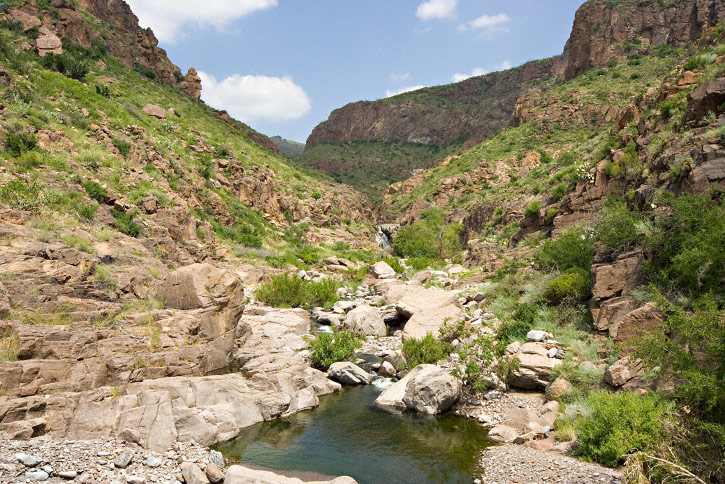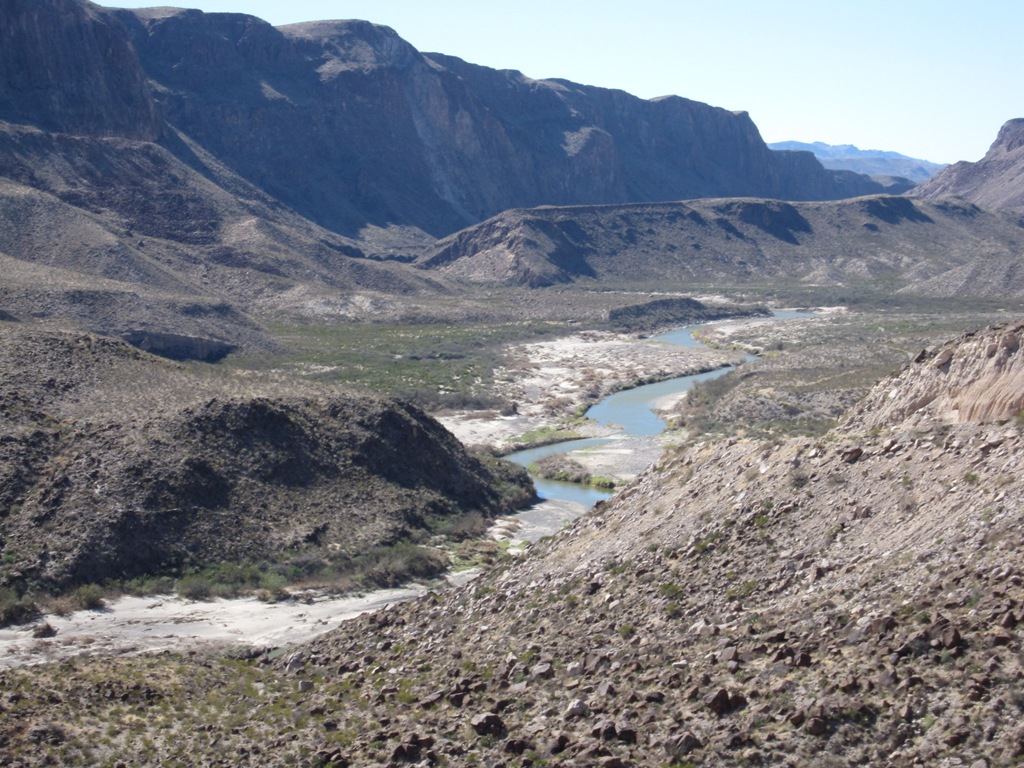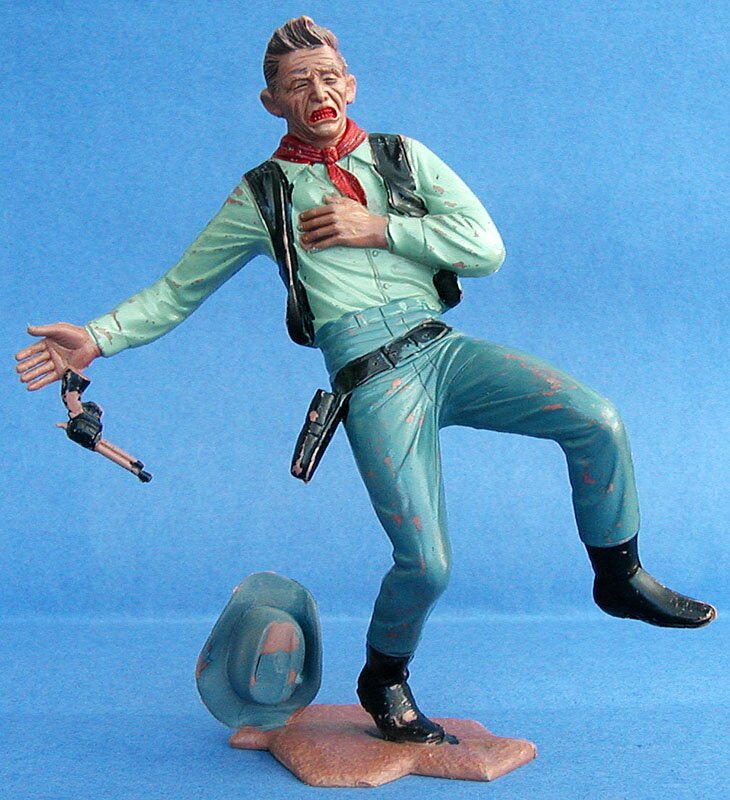Outlaw Jesse Evans and three of his gang saddle up and head for the Mexican border. In Fort Davis, Texas, they have been tipped off to the arrest of their compadre, Capt. John Tyson (real name John Selman).
they have been tipped off to the arrest of their compadre, Capt. John Tyson (real name John Selman).
 they have been tipped off to the arrest of their compadre, Capt. John Tyson (real name John Selman).
they have been tipped off to the arrest of their compadre, Capt. John Tyson (real name John Selman).
Stopping in Presidio, Texas, just shy of the Mexican border (see map on opposite page), Evans openly buys a new pair of boots in an apparent attempt to convince authorities that he is on the way out of the country. Instead, Evans and crew make a feint towards Old Mexico, then head northwest towards a hideout in the Chinati Mountains.

Riding all night and covering some 70 miles, a Texas Ranger patrol led by Sgt. Ed Sieker stops to water its horses on Cibola Creek, 18 miles north of Presidio.
18 miles north of Presidio. One of the Rangers notices a group of riders up on a distant ridge watching them. Using field glasses, the Rangers take a closer look, and as they do, the men on the mountainside move away.
One of the Rangers notices a group of riders up on a distant ridge watching them. Using field glasses, the Rangers take a closer look, and as they do, the men on the mountainside move away.
 18 miles north of Presidio.
18 miles north of Presidio. One of the Rangers notices a group of riders up on a distant ridge watching them. Using field glasses, the Rangers take a closer look, and as they do, the men on the mountainside move away.
One of the Rangers notices a group of riders up on a distant ridge watching them. Using field glasses, the Rangers take a closer look, and as they do, the men on the mountainside move away.
Riding forward to investigate, the Rangers soon take fire as the four horsemen mount up and head to the higher ridges. A running gunfight ensues for over a mile as the outlaws climb higher and higher up the range.
Trapped at the ridgeline, the four outlaws dismount and make a stand behind a rock outcropping. Led by Sgt. Sieker, the Rangers also dismount and charge forward, firing. Ranger D.T. Carson gets outlaw George Graham in the side, but Graham keeps firing down at the advancing lawmen. As Graham peeks up for another shot, Sgt. Sieker shoots the outlaw in the head, killing him instantly.
in the side, but Graham keeps firing down at the advancing lawmen. As Graham peeks up for another shot, Sgt. Sieker shoots the outlaw in the head, killing him instantly.
 in the side, but Graham keeps firing down at the advancing lawmen. As Graham peeks up for another shot, Sgt. Sieker shoots the outlaw in the head, killing him instantly.
in the side, but Graham keeps firing down at the advancing lawmen. As Graham peeks up for another shot, Sgt. Sieker shoots the outlaw in the head, killing him instantly.
Seeing Graham fall, the outlaws raise their hands and surrender. The Rangers quickly run up to the fortified position and disarm their prisoners.
Only after the surrender do the Rangers realize that one of their squad has been killed. While looking for a knife lost during the fight, Ranger L.B. Caruthers discovers the body of Ranger George Bingham, lying behind a bush, his lifeless hands gripping his Winchester. From his position on the ground, the Rangers theorize that he was gamely trying to pump another round in the magazine at the time of death.
Sieker later states, “I should have killed them all.”

Billy the Kid and Jesse Evans
The Kid is believed to have first met Evans in the fall of 1877 soon after Billy killed his first man near Camp Grant, Arizona , and fled back to the Silver City, New Mexico,
, and fled back to the Silver City, New Mexico, area. Riding with Jesse and other members of a loose-knit gang of rustlers known as “The Boys,” Billy and Jesse caroused in the Mesilla-El Paso area. Legend says that the Kid eventually gravitated to Lincoln County via Seven Rivers, while Jesse and the Boys went up the Tularosa side of the mountain.
area. Riding with Jesse and other members of a loose-knit gang of rustlers known as “The Boys,” Billy and Jesse caroused in the Mesilla-El Paso area. Legend says that the Kid eventually gravitated to Lincoln County via Seven Rivers, while Jesse and the Boys went up the Tularosa side of the mountain.
 , and fled back to the Silver City, New Mexico,
, and fled back to the Silver City, New Mexico, area. Riding with Jesse and other members of a loose-knit gang of rustlers known as “The Boys,” Billy and Jesse caroused in the Mesilla-El Paso area. Legend says that the Kid eventually gravitated to Lincoln County via Seven Rivers, while Jesse and the Boys went up the Tularosa side of the mountain.
area. Riding with Jesse and other members of a loose-knit gang of rustlers known as “The Boys,” Billy and Jesse caroused in the Mesilla-El Paso area. Legend says that the Kid eventually gravitated to Lincoln County via Seven Rivers, while Jesse and the Boys went up the Tularosa side of the mountain.
Ironically, the two landed on opposite sides of the fence in the brewing Lincoln County War, with Jesse riding for the House (Dolan and Murphy) and the Kid riding for Tunstall (and McSween). Both bravos survived the war and each other.

On the night of February 18, 1879, they decided to make peace. Stepping out from hiding on either side of Lincoln’s only street, the two shook hands and vowed to formally end hostilities.
The truce lasted only several hours as the celebrating, drunken en-tourage stumbled across Susan McSween’s lawyer on the street. Two of Jesse’s buddies, Billy Campbell and probably also Jimmy Dolan, started taunting the lawyer with their guns, which went off, killing the lawyer. The group then sauntered over to another saloon, but upon second thought, someone asked the Kid to place a pistol on the body to make it seem as if the lawyer had been armed. The Kid agreed to do the task and skinned out for Fort Sumner. That’s the last time the two outlaws saw each other.
So it’s more than a little ironic that when Jesse Evans landed in the pit jail in Fort Davis, Texas, he wrote a letter to the Kid (of all people), asking him to come save him. The letter suggests a stronger bond than most would have expected.

So why didn’t the Kid help out Jesse? The answer is found in Ranger C.L. Nevill’s report of August 26, 1880:
The prisoners are getting restless. I have a letter they wrote to a friend of Evans in New Mexico calling himself Billy Antrum to cause their rescue, and to use the words he was “in a damned tight place only 14 Rangers here any time, ten on scout and only four in camp now,” and that Antrum and a few men could take them out very easy and if he could not do it now to meet him [Evans] on the road to Huntsville [prison] as he was certain to go. I understand this man Antrum is a fugitive from somewhere and a noted desperado. If he comes down and I expect he will, I will enlist him for a while and put him in the same mess with Evans & Co.
The authorities intercepted that letter, and even though the Ranger suspected another would get out to Billy, no record of such exists. It is likely Jesse had no idea his letter was intercepted, and when the Kid didn’t come, he made other plans.
The Bad Guys:
• Jesse Evans. Went by a host of aliases. Captured.
• Charles Graham, alias Charles Gross, Graves, Groves. Captured.
• August Gross, alias Gunter. Captured.
• George Graham. Probably went by alias of Gross, Graves, Davis, Evans, etc. Killed.
• John Selman, alias Gunter, Gross, Captain Tyson. In Jail.
• Albert Graham, alias “Ace” Carr. In Jail.

A Dashing, But Short Outlaw
Jesse Evans: Born in 1853, five feet, three-quarters inches tall, weighing 150 pounds, with fair complexion, gray eyes and light hair. He has two large scars on the left thigh, one above his left elbow and another below.
Aftermath: Odds & Ends
John Selman was sent to Texas’ Shackelford County, where they evidently didn’t want him much because they put him on a nag and told him to “ride hard, fast, and far,” as the authorities fired their pistols in the air for added inducement. Selman landed in El Paso, Texas, where he took up the badge and later became notorious for killing John Wesley Hardin.
where they evidently didn’t want him much because they put him on a nag and told him to “ride hard, fast, and far,” as the authorities fired their pistols in the air for added inducement. Selman landed in El Paso, Texas, where he took up the badge and later became notorious for killing John Wesley Hardin.
 where they evidently didn’t want him much because they put him on a nag and told him to “ride hard, fast, and far,” as the authorities fired their pistols in the air for added inducement. Selman landed in El Paso, Texas, where he took up the badge and later became notorious for killing John Wesley Hardin.
where they evidently didn’t want him much because they put him on a nag and told him to “ride hard, fast, and far,” as the authorities fired their pistols in the air for added inducement. Selman landed in El Paso, Texas, where he took up the badge and later became notorious for killing John Wesley Hardin.
Jesse Evans was found guilty of second-degree murder and sentenced to 10 years in the state prison at Huntsville Penitentiary. Arriving at Huntsville on December 1, 1880, Evans entered as prisoner #9078. Almost 18 months later, on May 23, 1882, Evans went over the wall and disappeared from history.
The Graham brothers had a better lawyer (and a wealthy father) and skipped out after being released on bond.
August Gross joined Jesse at the Huntsville Penitentiary. He was reportedly released after three or four years and returned to Fort Davis to live out his days.
Recommended: Jessie Evans: Lincoln County Badman by Grady E. McCright and James H. Powell, Creative Publishing Company.
Frederick Nolan is preparing for publication a Billy the Kid Reader—a selection of the most important books and articles on Billy the Kid from 1881 to the present day.
No comments:
Post a Comment